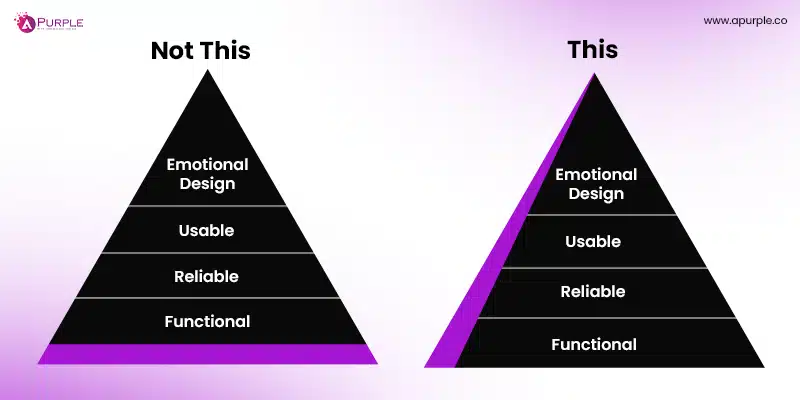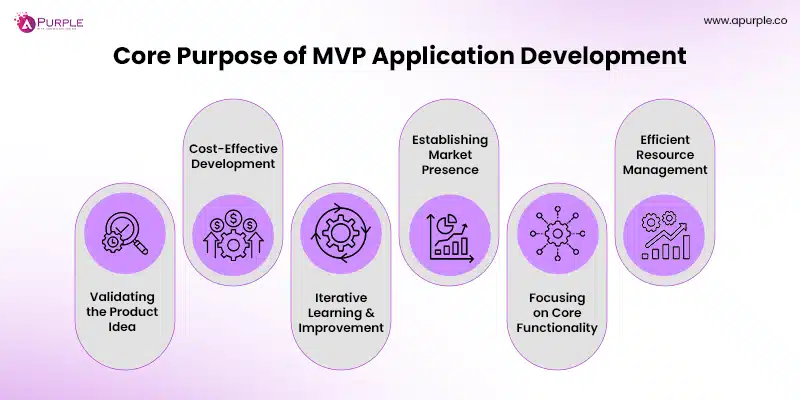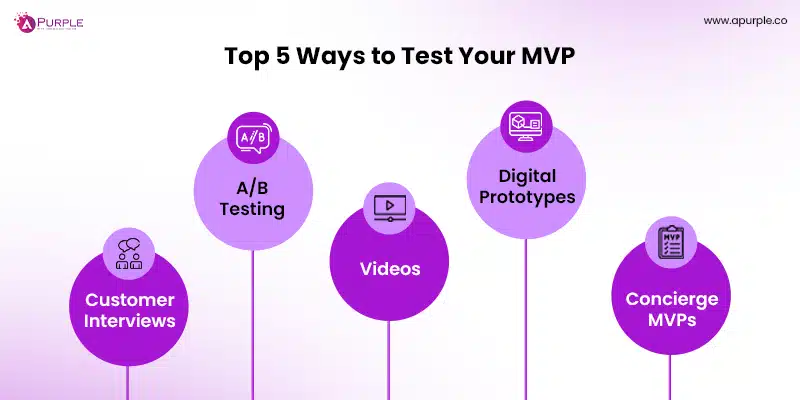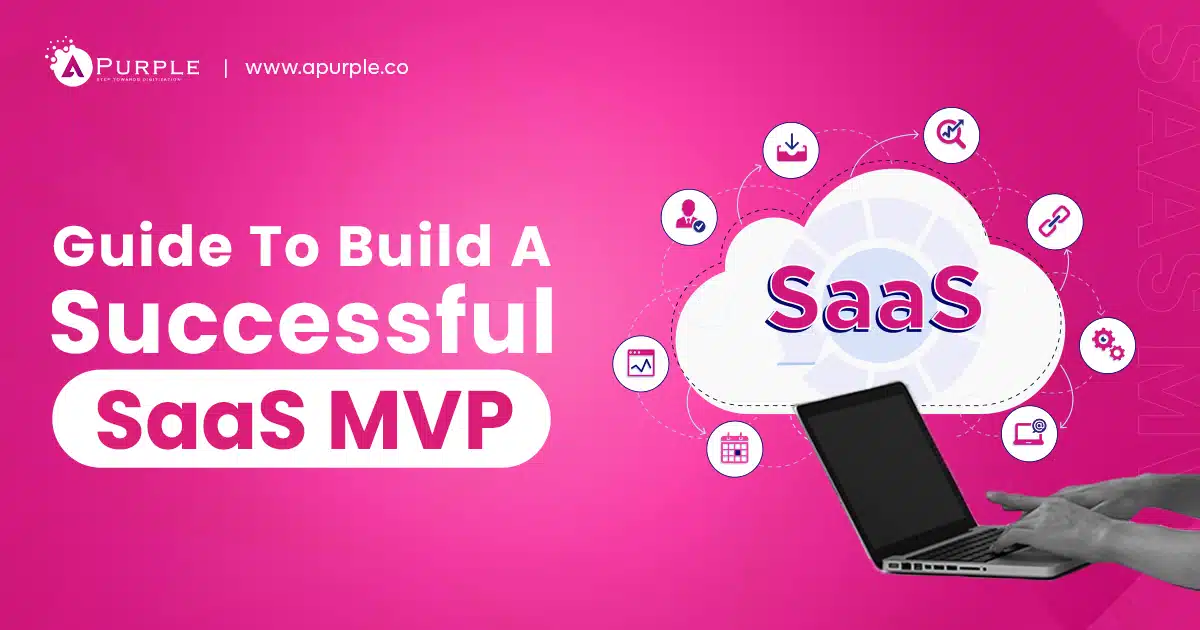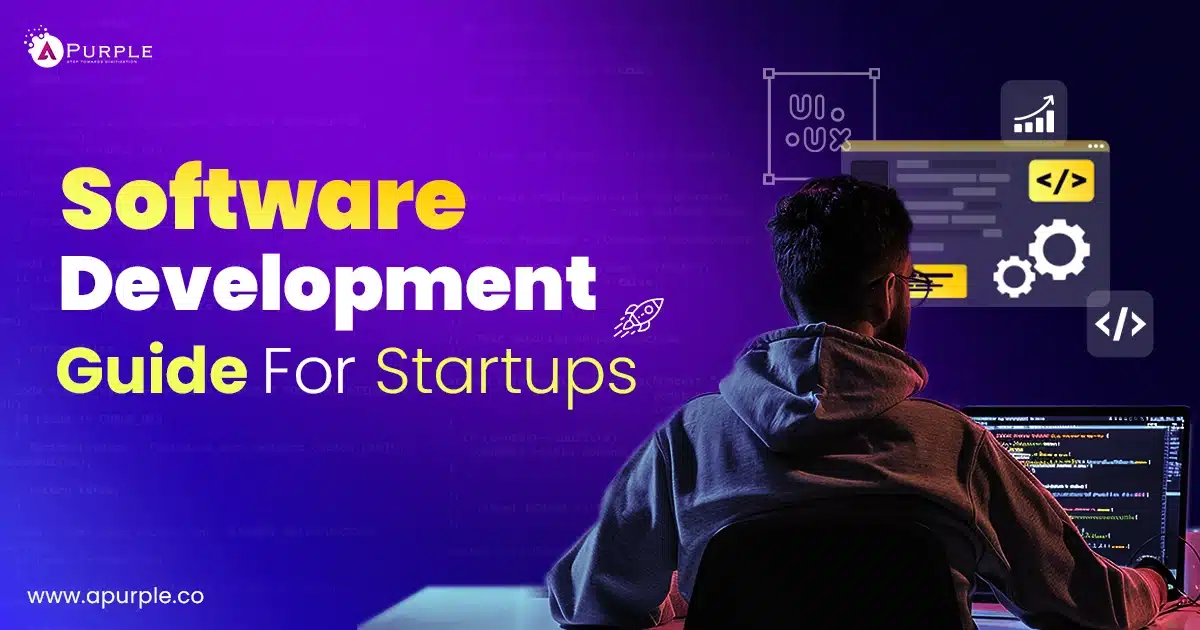Facebook, the tech giant we know today, started as a simple platform back in 2004. Then, called “TheFacebook,” it was initially limited to Harvard students and featured basic functions like profile creation and friend connections.
However, success doesn’t come without challenges. For startups, launching a new software product requires a well-established strategy, especially in today’s competitive environment.
According to CB Insights, 42% of startups fail due to a lack of market need. Startups that prioritize MVP app development have a 70% success rate, as per Harvard Business Review.
This is where MVP development becomes crucial. By focusing on the main features, MVPs (Minimum Viable Product) allow startup owners to test their ideas, gather user feedback, and refine their offerings without investing heavily in unproven ideas. Unfortunately, many startups skip this decision and fail to survive in today’s tech-driven market, missing the opportunity to iterate strategically.
How can an MVP help you validate your idea and position your business for success in this competitive market? Let’s start the journey of developing a winning MVP app.
What is MVP in Mobile App Development?
MVP in mobile app development allows you to test your innovative ideas. Suppose you have a raw diamond idea with full potential, but it must still be cut, polished, and refined before revealing its beauty. This is the point where MVP (Minimum Viable Product) comes. In this, you can determine whether your idea for the mobile app development will meet the market expectations.
Let’s understand with a simple analogy: If you plan to start a restaurant, its MVP will be a food truck. That will make it simpler and quicker to take customers’ feedback. Also, it will help you to inspect –
- Your Menu
- Pricing
- Gauge Customer Demand
- Experiment with Different Locations
In addition, MVP is a strategic approach for startup owners that helps them reduce risk, iterate quickly, and more. To understand better, see the image.
The first pyramid, stated with “Not This,” implies prioritizing “emotional design” at the top. It suggests it gets attention after usability, reliability, and functionality. Moreover, it clearly shows that functionality or features are the first thing at the cost of user experience and design.
Another pyramid, stated with “This,” has the “emotional design” as its base. It indicates that how a user sees a product is as vital as its functionality, reliability, and usability.
Furthermore, investing resources in your ideas with MVP is safe, as it follows a build-measure-learn process. With continuous opportunities for improvement, you can find better ways to serve your customers.
What is the Core Purpose of MVP in Mobile App Development?
While developing MVP for startup apps, it faces many hurdles, from limited resources to a restricted budget to quickly entering the market. Here is the point where MVP becomes essential for every startup. MVP helps startups in the following ways –
1. Validating the Product Idea
Validating the product idea serves as a litmus test for startup owners. Because it answers essential questions such as
- Is there an actual demand for this product?
- Does this app, website, or software development solve the problem it’s intended to solve?
- Which features are essential for the app?
- What metrics or KPIs should I track?
- What are the risks and costs?
All the answers to the above questions only came from early users who interacted with the app’s key functionalities.
2. Cost-Effective Development
Developing MVP startup apps is a cost-effective strategy that reduces development time and expenses by concentrating on must-have features. In addition, it helps startups to avoid the pitfalls of developing full-fledged, feature-rich applications that do not meet their needs.
3. Iterative Learning and Improvement
MVP app development services are crucial learning tools for startups. It helps them collect insights and improve their offerings based on user experience with their product or application.
Learning tools are essential for standing out in a crowded and competitive market. User feedback, surveys, questionnaires, user tracking, and more make this possible.
4. Establishing Market Presence
MVP is a pillar for many startups, enabling them to enter the market quickly, establish their presence, and build a user base. Establishing a market presence will help them attract investors for initial funding, and with the proper validation, they can expand their MVP app to an advanced application.
5. Focusing on Core Functionality
Choosing the core functionality is crucial for smooth operation of the app. To understand this better, let’s see one small example –
If you’re planning to build a fitness app, then the core functionality will be
- User Onboarding
- Activity Logging
- Progress Tracking Goal Setting
- Basic Recommendations
- Notification and Reminders
6. Efficient Resource Management
As a startup owner, you’ve faced resource constraints. MVP app development helps owners work with limited resources, whether time, money, or workforce, by concentrating on the app’s main aspects, such as its design, features, or frameworks.
Why is MVP Apps Important for Mobile Apps?
More than a decade ago, when the market of mobile apps was not oversaturated, it was easy to build an MVP app and get instant success. Today, users do not want to compromise with top-notch features, security, aesthetics and ease of use. MVP in mobile app development gives you plenty of opportunities to improvise on the go. Here are key advantages of MVP that lure the startup owners:
- It allows startup owners to enter the market as fast as possible, with plenty of scope to make required changes to the app later.
- You can create quite valuable products with a minimal budget.
- MVP mobile application is a perfect way to delight customers and impress investors even with the availability of fewer resources.
- With constant monitoring, you can find areas in the app for improvement and can make an effective startup business model.
Remember that you won’t have a feature-packed version of your app, but if you have built it right, it will undoubtedly develop smoothly over time.
How to Build an MVP from Scratch?
Here is the list of all the steps you’ll need to take to build an MVP for your mobile application. Your MVP app developer should carry out the work using an MVP template. Here are the steps we recommend for building an MVP for mobile apps.
#1. Conduct Market Research to Identify User Problems
The first and essential MVP app development step for mobile app is to conduct comprehensive market research. Spend as much time as possible identifying the core problems users face, how competitors’ apps are performing, seeing the features offered by their apps, and checking the ratings and reviews these apps have received. This will give you a clearer idea about users’ expectations and what features your app needs to meet to stand out in the market.
#2. Create a Plan
Market research with competitors’ analysis will help you create a plan to minimize the risk and ensure desired results. Here are some of the aspects your planning should cover:
1. Outlining Success Criteria
To stay on track with your goals, imagine the desired outcomes and set clear metrics to measure them. Track the number of downloads, active user percentages, and average ratings.
2. Set Long-term Goals
Think ahead about what you want to achieve after launching your MVP app. Decide how long you’ll collect feedback and how thoroughly you’ll analyze it. These long-term plans can significantly impact your app’s success.
3. Create a Strong Management
Create a plan that outlines how to build your ideal team and identify the key stakeholders you want to engage. This will help ensure you have the right people and connections to support your app’s growth.
#3. Identify Features and Services
Now that you know users’ core problems and have created a complete plan, it’s time to identify features that will work for your app and the users. Your goal at this stage should be to solve users’ perceived problems by including necessary features. According to GoodFirms, prioritizing must-have features is a stage in which 22.5% of businesses focus 56%-70% of their time and efforts. At the same time, as the name says, you should keep the minimum required features and functions in the app for testing. However, it would be best to prioritize the features to include or exclude from the app, at least at this stage. Ensure each feature is accurately integrated to solve users’ perceived problems.
- Feature prioritization can help you get it right the first time. It is usually used before app development but is also helpful during inspection. The method allows you to identify the features most likely to meet the app’s requirements. Let’s understand the feature prioritization method in detail. Look at the following image for a better idea of feature prioritization.
- Features that require a low budget and less time and will have a high impact are essential for your app.
- Features requiring a high budget, time, and resources and causing minimum impact should be avoided at all costs.
- Features with low budgets and low effects and features with high budgets and implications should be given a second thought.
#4. Discover the Most Suitable Revenue Model for Your App
Before commencing the mobile app development MVP, you should identify the revenue model for your mobile app. Several options include pay-per-download, subscription-based models, or in-app purchases. Choose the best MVP app development company to determine the best revenue model for effectively monetizing the app. While deciding the revenue model, remember to consider the overall user experience, ensuring that the revenue model is not intrusive in any way.
#5. Create a Prototype
This is one of the most critical steps of the entire MVP mobile app development process. Creating a prototype of your app is essential to testing the user journey with internal stakeholders and focus groups. In addition, it allows an MVP app developer to achieve perfection by removing all the bugs while validating UI and UX. Before launching the MVP app, ensure you have tested all the functional and non-functional elements.
#6. Build the MVP Mobile App
It’s time to build the MVP template. Use all the intelligence and data gathered from the above steps. Do not hesitate to launch the app, and ensure that you have completed 90% of the development before you start thinking about launching it. Before you launch, one of the most crucial aspects of MVP in app development is to consider the loading times. If users experience lag, they won’t hesitate to drop the app and never return.
#7. Test and Launch It
You have fixed all the bugs and glitches, tested the app, and ensured all features are working correctly, and now it’s time to launch it. But before launching your MVP, make sure that your app does not contain any bugs. Once everything is done, it’s high time to show your app to the world. Whether you built it for investors or users, let them enjoy your creation. You can spread the word about your app after launching it with content marketing, social media marketing, influencer marketing, etc.
Top 5 Ways to Test Your MVP
Everything is fine, from defining the core purpose to the steps to build an MVP in mobile app development, but testing it to check if your decision is correct is a must. Then, quickly learn the top 5 ways to test your custom MVP app development services.
1. Customer Interviews
Pro Tip – Collect the insider scoop from your targeted audience.
Gathering insights from the audience face-to-face will bring honesty to your MVP web application development. Ask them to grade your MVP app on a 1-10 scale.
2. A/B Testing
Pro Tip – Experiment with Variations for Optimum Outcome
A/B testing permits you to test in two different product versions. You have to choose only one validation parameter at a time. The logic of A/B testing is to split the traffic between two versions randomly or equally. You can analyze it with tools like Google Analytics, Unbounce, etc
3. Videos
Pro Tip – Use explainer videos to grab traction and showcase your MVP.
The explainer video will help your targeted audience better understand the product’s value. To grab the attention of your users, then you must focus on the core aspects of your custom MVP app development services, such as the reason for the launch, features, and how it works.
4. Digital Prototypes
Pro Tip – Digital Prototypes will provide a sneak peek of your MVP
This involves showcasing actual products to your audience in a digital way. You can show your product website or application through wireframes or mockups to take your user to the next level. An MVP app development company will help you prepare the wireframes or mockups.
5. Concierge MVPs
Pro Tip – Offer concierge MVP to provide a personalized touch
The concierge approach only gives a customized touch to specific customers. It helps your users to understand your final product in real life. Rent the Runway uses this approach in its clothing rental business. From this, they get accurate and honest results from the users of their product.
Mistakes to Avoid When Developing an MVP
Now that you know the steps to developing and testing the MVP for your mobile app, you should also know what mistakes to avoid throughout the project. Avoiding the following five mistakes for MVP development will brighten your chances of getting the desired outcome.
1. Postponing Monetization
This is one of the first pitfalls you want to avoid when developing an MVP mobile application as a startup owner. Your customers do not care whether your app is a complete product, so you should not as well, at least when implementing a solid monetization strategy.
2. Not Having a Feature-Balanced App
You want your mobile app to be highly functional but don’t confuse too many or too few features with high functionality. Select and add features carefully to add value to the app’s overall experience. You might spark a few new ideas during the app development but don’t get too excited and work on all of them. Evaluate the ideas and see their impact on integration time, time to market, cost, and ROI.
3. Building MVP From the Scratch
With plenty of open-source and commercial tools available, don’t spend time developing your MVP mobile app from scratch. With ready-to-use templates, you can finish months of work within weeks. Don’t hesitate to use third-party tools to speed up the development process.
4. Insufficient Marketing Budget
As a startup owner, you run the entire show on a strict budget. However, it would help if you spent only a portion of your budget on development. You should also have a sufficient budget for marketing your app. Remember, the competition is tough, and more apps are developed and launched in the market every day. You should have a sufficient marketing budget to survive and thrive in the competitive market.
How to Measure MVP Success? – KPIs and Metrics
Developing an MVP for startup apps is just a start, but how do you get a hint about its success? This is a point where you need to know about different KPs and Metrics to measure your MVP’s success. Without wasting much time, let’s jump into this quickly.
Key Performance Indicators (KPIs) of MVP in App Development
Key Performance Indicators (KPIs) help you to identify the effectiveness of your MVP. It helps you to get an analysis of how your MVP is satisfying your user’s needs and drives business goals. So, let’s understand the major KPIs for your MVP’s success.
1. User Engagement Metrics
The most important thing for your MVP is it should be interactive for your users. In other words, these metrics show you whether your MVP meets your user’s needs and expectations. Under user engagement metrics, you’ve to check the following things regularly –
-
Active Users
Imagine your MVP as a SaaS (Software as a Service) startup, where you can track your active users every time they log into your platform at least once a week. If active users continuously increase, your MVP will resonate with customers.
-
User Retention Rate
This KPI involves a little mathematical theory. For example, if out of 100 users in the first month, 70 come back in the next month, then the user retention rate will be 70%. If the retention rate is high, it indicates that your users love your product.
-
Time Spent
Time spent appraises the duration spent by the user on your app, software, or website. Spending more time on your app or website will make the user feel more connected and engaged with your MVP application development.
-
Conversion Rate
When the user spends sufficient time on your website or application, desirable icons such as a porch, using a product, signing up for a subscription, or registering for a service.
2. User Feedback and Satisfaction
Users are the most critical aspect of a startup in terms of their interactions, feedback, satisfaction, and many others. By analyzing your customers, you can beat their satisfaction level, identify areas of improvement, and refine your product for better customer results. But for the exact results you need to know about –
-
Net Promoter Score (NPS)
The NPS measures customer loyalty and satisfaction with MVP products or applications. It is based on customers’ recommendations to their friends and family. To do this, you must ask your user one question: “On a scale from 0 to 10, how likely are you to recommend our application, website, or software to a friend or colleague ?”
Plus, the users are divided into three groups according to their answers: Promoters (9-10), Passives (7-8), and Detractors (0-6). The formula to calculate is NPS = % of Promoters – % of Detractors.
-
User Surveys and Feedback
This KPI is designed to collect data on user experience for a specific application, website, or software. It ultimately helps you understand user preferences, problems, and desires.
-
Product Performance Metric
A product performance metric will help you optimize your product. Businesses can track it to check how well their app or website performs and meet users’ needs.
-
Loading Time and Performance
Loading time defines the time it takes for a page to load fully. The faster the page loads, the more time the user will spend on your website.
3. Business Metrics
Business metrics are defined as those that optimize the effectiveness of a startup’s MVP. The metrics below will assist you in achieving business goals, interpreting user behavior, and validating your business model.
-
Revenue and Return on Investment (ROI)
This metric tells you about your business’s sales and the return on your investment. A high ROI depicts increased revenue and profit.
-
Customer Acquisition Cost (CAC)
The cost includes acquiring new customers through marketing and sales expenses. For example, if you spent $100 to market your product and got ten people to buy it in 1 week, then the acquisition for that week is $10.
-
Lifetime Value of a Customer (LTV)
The lifetime value of a customer is the total revenue you estimate from one customer throughout their relationship with your business. If the lifetime value of a customer is slightly higher than the customer acquisition cost, it portrays that your business is sustainable and profitable.
4. Market Metrics
Evaluating the victory of your MVP application development with the broader market context. Market metrics show how well your MVP performs with market demand, competition, and user interaction. The metrics support you to lead the marketplace with your application, website, or software. It includes some strategic metrics, such as
-
Market Penetration
Market penetration measures the percentage of your targeted audience that is our MVP. It is estimated by dividing the number of users of your MVP by the total number of potential users in the market.
-
Competitor Analysis
Analyzing your competitor’s offerings and performance is crucial to measuring the market. In short, do a SWOT (Strengths, Weaknesses, Opportunities, and Threats) analysis of your competitors. This also includes their strategies, such as pricing strategies, user engagement strategies, and marketing strategies.
-
User Growth Rate
When a startup starts acquiring customers or building a rigid user base, it depicts a positive sign of the startup in terms of profits, user engagement, customer satisfaction, or customer loyalty. User growth rate measures the speed at which users are acquired over a specified period.
Key Metrics for Your Custom MVP App Development Services
Key metrics are the metrics that will help you in examining the user behavior, app performance, and overall business impact, assisting you in making data-driven decisions for your MVP success. So, let’s look into the main metrics for your custom MVP app development services-
| Type of Metric | What Defines the Metric |
|---|---|
| Number of Downloads | The total number of your application downloads or installations should indicate the user’s interest in and reach of the application. |
| Percentage of Active Users | More than installing your MVP application is required. User’sUsers should be active on it daily, weekly, or monthly. This directly indicates stickiness and engagement. |
| ARPU (Average Revenue Per User) | ARPU is related to financial performance and revenue potential per user. It is the average revenue generated per user over a specific period. |
| Churn Rate | The churn rate defines the user’s dissatisfaction after downloading or installing your application. However, it does not fully reflect the MVP’s success. |
| User Ratings | When the user experience is successful, they give a rating in the form of stars. This gauges overall customer satisfaction and product quality. |
How Much Does it Cost to Develop an MVP?
Know the key to measuring the MVP’s (Key Performance Indicators) KPIs and metrics from the stages of MVP app development. The most emerging thought of any startup owner or entrepreneur is the MVP app development cost.
In the MVP app development process for mobile app, you should focus on the main functionalities of the app, platform, or software based on your research and users’ needs. The table below showcases the MVP app development cost based on its complexity.
| Complexity of MVP | Features | Estimated Cost |
|---|---|---|
| Simple MVP |
|
$2,000 to $15,000 |
| Medium MVP |
|
$15,000 to $40,000 |
| Advanced MVP |
|
$40,000 to $150,000 |
Note – The above table shows the cost of MVP development for mobile app, which is estimated and might be changed according to its complexities.
5 Common Startup Pitfalls and How to Avoid These Pitfalls
Why does MVP fail? Many ignore three main things: MVP app development’s minimum viable journey is like sailing on an adventurous trip. So, let’s know the top mistakes that sink startups.
1. Sailing Without the Destination: Lack of Target Market Niche
If the target market is already occupied with the product, application, or website you have an idea for, there might be a higher chance of failing. Your competitors are already playing with them, solving users’ problems. At this point, your idea becomes an option instead of a definite choice that’ll benefit people.
Solution
To avoid this, you must take proper time to research your competitors and your ideas. It would help if you also tried to connect with your target audience through surveys, interviews, focus groups, and other methods. Doing this will help you validate your idea more strongly.
2. Managing Without Map: Too Poor MVP Strategy
Making a strategy is the foremost thing for anything. As you know, a great product can only succeed if the strategy is well-planned. In this, you have to ask some questions to yourself, such as
- Why are you doing this
- How you’ll do this
- What impact does it create on your targeted audience and your startup journey
- Does the problem that you’re solving have a sense of urgency for the market?
- Which strategies does the market use to solve the problem?
- Is your solution different and unique from other solutions?
Solution
First, clarify your goal and aim for the business. Make sure that your MVP should address market needs and preferences. Watch your competitors stand out with a minimalistic MVP application. Keep brainstorming about the feedback and make different strategies to create a successful MVP app.
3. Trying To Fix Non-Existence Problems: Addressing Non-Issues
Many startup owners make this common mistake when making an application, software, or website that the market does not need. This involves questions like
- Is your idea for the application, software, or website necessary for the audience?
- Are there people who will download, install, or visit your application, software, or website?
- What should be the market for your application?
The answer will depend on the needs of your application, software, or website. But if you make something the market doesn’t need, you will lose money, time, and effort.
Solution
It has the same solution, requiring thorough research to validate your idea from surveys, interviews, or other sources. This helps you understand their pain points, needs, and preferences and ensures your MVP solves a relevant and urgent problem for them.
4. Overloading the Ship: Feature Overwhelm
An MVP application, software, or website should be integrated with minimum functionality to validate your idea among users. MVP app development helps you identify your idea faster. Still, if you squeeze so many unnecessary features, it will take development time, slowly become expensive, and increase the chances of failure.
Solution
The solution is to pick or ask your MVP app development company only to handpick the most essential features. This will help you launch your app faster and determine whether your MVP is a failure or a success.
5. Leaking Below Deck: Poor Technical Implementation
Have you ever downloaded an app or visited a website with many bugs? The bugs will ruin your mood; the same goes for your application, software, or website. If you are integrating features minimally, and there are not too many, but they have bugs, what should be the impact on your app or business?
Additionally, when building an application or software, fix the time you find and solve the bugs.
Solution
To avoid this failure, test throughout the MVP in mobile app development process to recognize and fix bugs early. Connect with a dedicated person who ensures every feature is bug-free and issue-free.
Final Thoughts
Once, Lao Tzu said, “The journey of a thousand miles begins with one step.” It depicts a startup owner’s journey, mainly if they want to change something big. This blog on MVP app development for mobile app covers everything possible, such as the core purpose of MVP, how to build an MVP, how to test your MVP, mistakes, and solutions for your MVP. In other words, MVP is one of the strategies any entrepreneur can use to improve user engagement, market traction, and ROI. In this, we tried to answer your question: What is MVP in app development?
The aPurple team has experienced app developers who will build an MVP app for you with all focus and dedication. Our team is proficient in solving problems, skilled in different technology stacks, and more.
Ready to validate your idea in the market? Contact us to discuss your MVP application development needs, and let’s build something extraordinary together.


